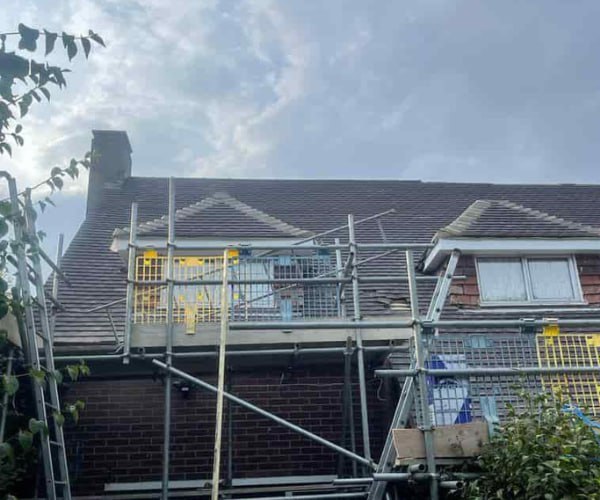Gable End Damp Issues: Could It Be a Roofing Fault?
Damp around the gable end of a property is a concern no homeowner should ignore. Whether it presents as peeling paint, stained plaster, or mould growth, gable end damp can lead to serious structural issues if left untreated. But while many assume the problem lies within the brickwork or internal ventilation, the real cause could be sitting right above—your roof. At LKN Roofing Shortstown, we regularly assist clients throughout Shortstown, Bedfordshire with identifying and resolving roofing-related causes of gable end damp.
Understanding Gable Ends and Why They’re Vulnerable
A gable end is the triangular upper portion of a wall located beneath the pitched edges of a roof. These areas are particularly exposed to the elements and prone to damp if the roofing or flashing around them has failed.
Gable end damp can result from:
- Direct water ingress
- Condensation caused by cold bridging
- Roof defects allowing moisture to seep into the wall cavity
- Wind-driven rain penetrating porous surfaces
Proper roof construction and ongoing maintenance are essential in preventing these issues from developing.
Common Roofing Faults That Cause Gable End Damp
Identifying the source of moisture is crucial in any damp investigation. Often, roof-related faults are found to be the root of the problem.
1. Damaged or Missing Verge Tiles
Verge tiles run along the edge of a gable roof and protect the ends of the tiles and underlay. If these tiles are cracked, dislodged or missing altogether, it can lead to:
- Wind-driven rain entering the roofline
- Exposure of roofing felt and battens
- Moisture reaching the inner wall surface
Over time, this results in visible damp patches along the inside gable wall.
2. Failed Mortar Bedding
Traditional gable verges may be bedded in mortar. With age or storm damage, this mortar can crack and fall away, leaving gaps for water to penetrate.
This is especially common in older homes across Shortstown, Bedfordshire where roof maintenance may have been overlooked.
3. Inadequate or Damaged Lead Flashing
Lead flashing should be securely installed where the roof meets gable walls or chimneys. If this flashing is missing, poorly installed, or split, water will be directed straight into the vulnerable wall junctions.
Signs of flashing failure include:
- Damp patches appearing after rain
- Water ingress during windy weather
- Flaking plaster or bubbling paint near roof edges
4. Poor Roof Ventilation
Trapped moisture within the loft space can lead to condensation forming along the inner gable end wall. This issue often arises from:
- Blocked or absent soffit and ridge ventilation
- Lack of breathable membrane
- Inadequate insulation
Over time, condensation can mimic penetrating damp and cause significant damage if not identified and resolved.
5. Gutter or Valley Problems
Water cascading from blocked or overflowing gutters can saturate gable end walls. Similarly, valleys running into the gable may leak if flashing or tiling is defective.
This is especially problematic in properties with complex roof structures or insufficient fall on the guttering system.
Why a Roofing Inspection Is Essential
Too often, property owners spend money on internal damp treatments that only mask the symptoms without addressing the source. Before investing in remedial plastering or damp-proofing, a professional roofing inspection is recommended.
At LKN Roofing Shortstown, we provide:
- Thorough inspections of verge tiles, flashings and roof coverings
- Moisture tracking to determine ingress points
- Identification of hidden faults not visible from the ground
- A clear, honest report outlining required repairs
This allows homeowners in Shortstown, Bedfordshire to make informed decisions and resolve the root issue—saving time and money in the long run.
Long-Term Solutions for Gable End Damp
Depending on the findings, a range of roofing solutions can help stop gable end damp at its source.
These may include:
- Replacing broken or missing verge tiles
- Re-bedding verges or installing dry verge systems
- Replacing or resealing lead flashing
- Improving roof ventilation and insulation
- Repairing or repositioning gutters and downpipes
All repair work should be completed by experienced roofing professionals who understand the relationship between external roofing faults and internal damp outcomes.
Conclusion
Damp in your gable end wall should never be ignored—but tackling the symptom alone won’t solve the problem. In many cases, the true cause lies in the roof. Whether it’s compromised verge tiles, failing flashing or poor ventilation, addressing these roofing faults is the only way to stop the damage from getting worse.
If you’ve noticed damp patches near the top of your internal walls, contact LKN Roofing Shortstown. Our team in Shortstown, Bedfordshire will carry out a detailed inspection and provide the right roofing solution to safeguard your home from further water damage. Don’t wait until it becomes a costly repair—act early and protect your property with expert help.
Call us on: 01234 860 695
Click here to find out more about LKN Roofing Shortstown
Click here to complete our contact form and see how we can help with your roofing needs.

